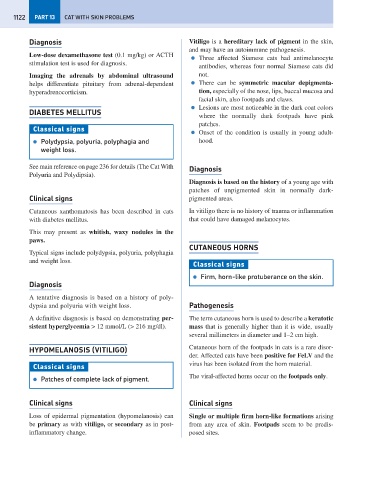Page 1130 - Problem-Based Feline Medicine
P. 1130
1122 PART 13 CAT WITH SKIN PROBLEMS
Diagnosis Vitiligo is a hereditary lack of pigment in the skin,
and may have an autoimmune pathogenesis.
Low-dose dexamethasone test (0.1 mg/kg) or ACTH
● Three affected Siamese cats had antimelanocyte
stimulation test is used for diagnosis.
antibodies, whereas four normal Siamese cats did
Imaging the adrenals by abdominal ultrasound not.
helps differentiate pituitary from adrenal-dependent ● There can be symmetric macular depigmenta-
hyperadrenocorticism. tion, especially of the nose, lips, buccal mucosa and
facial skin, also footpads and claws.
● Lesions are most noticeable in the dark coat colors
DIABETES MELLITUS
where the normally dark footpads have pink
patches.
Classical signs
● Onset of the condition is usually in young adult-
● Polydypsia, polyuria, polyphagia and hood.
weight loss.
See main reference on page 236 for details (The Cat With Diagnosis
Polyuria and Polydipsia).
Diagnosis is based on the history of a young age with
patches of unpigmented skin in normally dark-
Clinical signs pigmented areas.
Cutaneous xanthomatosis has been described in cats In vitiligo there is no history of trauma or inflammation
with diabetes mellitus. that could have damaged melanocytes.
This may present as whitish, waxy nodules in the
paws.
CUTANEOUS HORNS
Typical signs include polydypsia, polyuria, polyphagia
and weight loss.
Classical signs
● Firm, horn-like protuberance on the skin.
Diagnosis
A tentative diagnosis is based on a history of poly-
dypsia and polyuria with weight loss. Pathogenesis
A definitive diagnosis is based on demonstrating per- The term cutaneous horn is used to describe a keratotic
sistent hyperglycemia > 12 mmol/L (> 216 mg/dl). mass that is generally higher than it is wide, usually
several millimeters in diameter and 1–2 cm high.
HYPOMELANOSIS (VITILIGO) Cutaneous horn of the footpads in cats is a rare disor-
der. Affected cats have been positive for FeLV and the
virus has been isolated from the horn material.
Classical signs
The viral-affected horns occur on the footpads only.
● Patches of complete lack of pigment.
Clinical signs Clinical signs
Loss of epidermal pigmentation (hypomelanosis) can Single or multiple firm horn-like formations arising
be primary as with vitiligo, or secondary as in post- from any area of skin. Footpads seem to be predis-
inflammatory change. posed sites.

